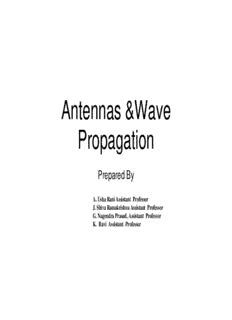
half-wave dipole antenna PDF
Preview half-wave dipole antenna
Antennas &Wave Propagation Prepared By A. Usha Rani Assistant Professor J. Shiva Ramakrishna Assistant Professor G. Nagendra Prasad, Assistant Professor K. Ravi Assistant Professor Basic Antenna Theory Purpose • to refresh basic concepts related to the antenna physics – needed to understand better the operation and design of microwave links and systems Outline • Introduction • Review of basic antenna types • Radiation pattern, gain, polarization • Equivalent circuit & radiation efficiency • Smart antennas • Some theory • Summary 3 Quiz We use a transmitting antenna to radiate radio wave and a receiving antenna to capture the RF energy carried by the wave. Somebody told that the receiving antenna also radiates radio waves during the reception. Is it a true fact or a slip of the tongue? 4 Intended & unintended radiators • Antennas intended to produce specified EM field – Radiocommunication antennas; Measuring antennas; EM sensors, probes; EM applicators (Industrial, Medical, Scientific) • Radiators not intended to generate any EM field, but producing it as an unintended side-effect – Any conductor/ installation with varying electrical current (e.g. electrical installation of vehicles) – Any slot/ opening in the screen of a device/ cable carrying RF current – Any discontinuity in transmission medium (e.g. conducting structures/ installations) irradiated by EM waves – Stationary (e.g. antenna masts or power line wires); Time-varying (e.g. windmill or helicopter propellers); Transient (e.g. aeroplanes, missiles) 5 Antenna purpose • Transformation of a guided EM wave in transmission line Space wave (waveguide) into a freely propagating EM wave in space (or vice versa) with specified directional characteristics – Transformation from time-function in one-dimensional space into time- function in three dimensional space – The specific form of the radiated wave is defined by the antenna structure and the environment Guided wave 6 Antenna functions • Transmission line – Power transport medium - must avoid power reflections, otherwise use matching devices • Radiator – Must radiate efficiently – must be of a size comparable with the half-wavelength • Resonator – Unavoidable - for broadband applications resonances must be attenuated 7 Monopole (dipole over plane) High-Q Low-Q Narrowband Broadband Smooth transition region Uniform wave traveling along the line • If there is an inhomogeneity (obstacle) a reflected wave, standing wave, & higher field modes appear • With pure standing wave the energy is stored and oscillates from entirely electric to entirely magnetic and back • Model: a resonator with high Q = (energy stored) / (energy lost) per cycle, as in LC circuits • Kraus p.2 8 Outline • Introduction • Review of basic antenna types • Radiation pattern, gain, polarization • Equivalent circuit & radiation efficiency • Smart antennas • Some theory • Summary 9 Antennas for laptop applications Source: D. Liu et al.: Developing integrated antenna subsystemsPropertyforlaptopcomputers;ofRIBMStruzakJ.RES.& DEV. VOL. 47 NO. 2/3 MARCH/MAY 2003 p. 355-367 10
Description: